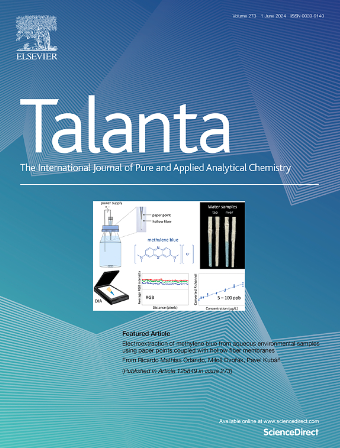生化需氧量比色检测新方法的建立及其在实际水体中的应用
IF 5.6
1区 化学
Q1 CHEMISTRY, ANALYTICAL
引用次数: 0
摘要
本研究构建了一种新型的高效比色生物传感器,用于生化需氧量(BOD)的视觉检测和酶标仪高通测量。以实际水原位培养的微生物和普鲁士蓝分别作为模式菌和比色生物传感器指示物。为准确检测水中BOD含量,对反应池浓度、K3[Fe(CN)6]浓度、反应温度、反应时间等条件进行了优化。最佳条件为OD600 = 7、10 mM、37℃、40 min。在显色反应过程中,优势菌群为不动杆菌、芽孢杆菌和流出杆菌。该传感器的检测范围为5 ~ 80 mg L−1,检出限为3.32 mg L−1。实际水体中BOD含量的相对误差为15.49%。综上所述,高效比色生物传感器能够快速、灵敏地检测BOD含量,在BOD检测领域具有潜在的应用前景。本文章由计算机程序翻译,如有差异,请以英文原文为准。

Development of a novel method of biochemical oxygen demand colorimetric detection and its application in actual water
In this study, a novel and efficient colorimetric biosensor was constructed for biochemical oxygen demand (BOD) detection based on visual analysis and Qualcomm measurement with enzyme-labeling instrument. Microorganisms cultured in situ with actual water and Prussian blue were used as model bacteria and indicator of colorimetric biosensor, respectively. To accurately detect BOD content in water, the reaction conditions such as cell concentration, K3[Fe(CN)6] concentration, reaction temperature, and reaction time were optimized. The optimal conditions were OD600 = 7, 10 mM, 37 °C and 40 min, respectively. The dominant bacteria in the color reaction process were Acinetobacter, Bacillus and Exiguobacterium. The detection range of the biosensor was 5–80 mg L−1, and the detection limit was 3.32 mg L−1. The relative error of BOD content in actual water was 15.49 %. In summary, the high-efficiency colorimetric biosensor can detect BOD content quickly and sensitively, which implied its potential application prospects in the field of BOD detection.
求助全文
通过发布文献求助,成功后即可免费获取论文全文。
去求助
来源期刊

Talanta
化学-分析化学
CiteScore
12.30
自引率
4.90%
发文量
861
审稿时长
29 days
期刊介绍:
Talanta provides a forum for the publication of original research papers, short communications, and critical reviews in all branches of pure and applied analytical chemistry. Papers are evaluated based on established guidelines, including the fundamental nature of the study, scientific novelty, substantial improvement or advantage over existing technology or methods, and demonstrated analytical applicability. Original research papers on fundamental studies, and on novel sensor and instrumentation developments, are encouraged. Novel or improved applications in areas such as clinical and biological chemistry, environmental analysis, geochemistry, materials science and engineering, and analytical platforms for omics development are welcome.
Analytical performance of methods should be determined, including interference and matrix effects, and methods should be validated by comparison with a standard method, or analysis of a certified reference material. Simple spiking recoveries may not be sufficient. The developed method should especially comprise information on selectivity, sensitivity, detection limits, accuracy, and reliability. However, applying official validation or robustness studies to a routine method or technique does not necessarily constitute novelty. Proper statistical treatment of the data should be provided. Relevant literature should be cited, including related publications by the authors, and authors should discuss how their proposed methodology compares with previously reported methods.
 求助内容:
求助内容: 应助结果提醒方式:
应助结果提醒方式:


